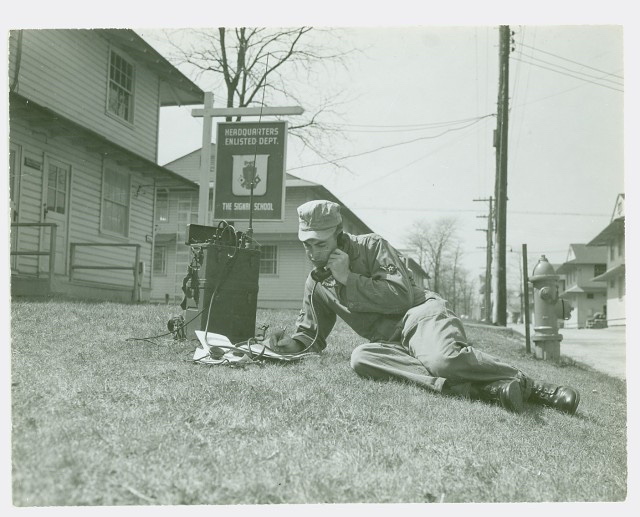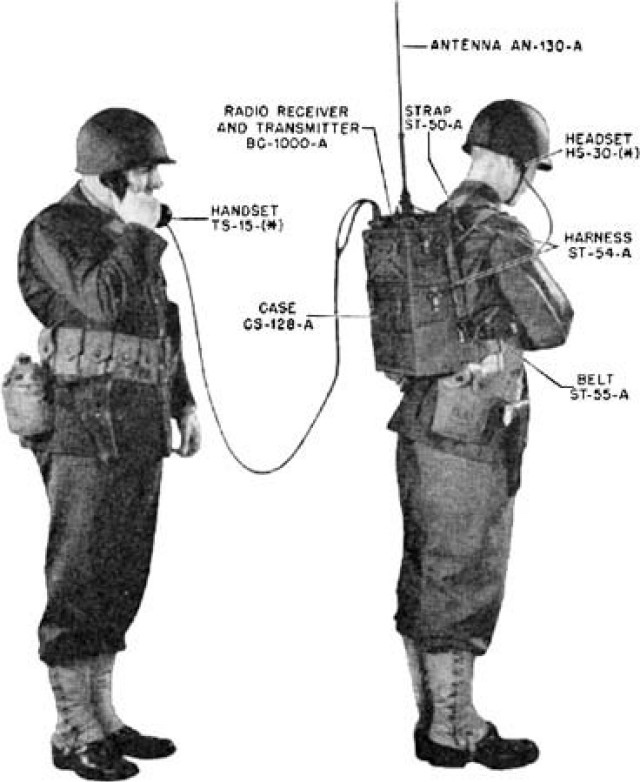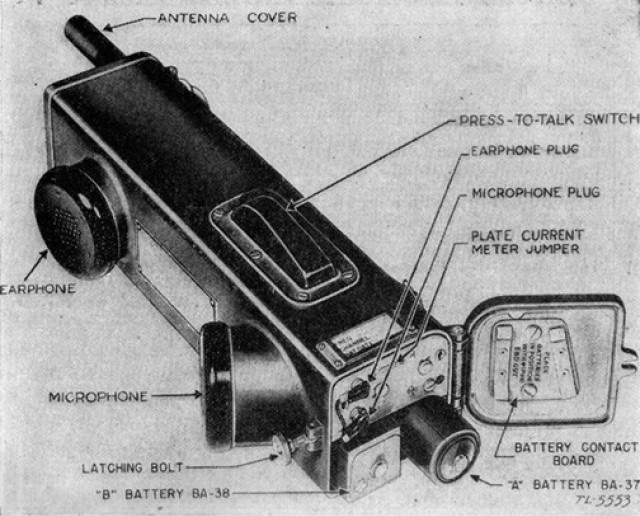
ABERDEEN PROVING GROUND, Md. —Seventy-years ago this month, in April 1952, the Signal Corps Engineering Laboratories (SCEL) sent a team of Soldiers and specialists to California Army, Navy, and Marine bases to introduce new equipment and train Soldiers on how to use and maintain the latest innovations, dubbed “OPERATION GOLD RUSH.”
The equipment included something that would go on to become a common-place in civilian life – the walkie-talkie portable radio, also known as the SCR-300.

In an era where we carry small computers in our pockets, it’s difficult to comprehend the innovations behind the new “light weight” equipment for military use. The walkie-talkie, originally weighing in at 40 pounds, was first used at the end of World War II, in both the European and Pacific theaters, to high praise from Soldiers. Carried as a backpack, the VHF (40 to48 MHz) FM transceiver could reliably reach out 5 miles in the field.
The set was used in amphibious landings in the Pacific, over water for distances up to 15 miles. It was actually the “handie-talkie” (SCR-536) that would take the form of a hand-held unit that is commonly thought of today.
Radio Set SCR-536 was a first in the military communications field. The designers incorporated the microphone, earphone, batteries, antenna, and all of the electronics in a single case with a total weight of less than 6 pounds. The earphone and microphone were so situated that by raising the case to the side of his face, the operator could talk and listen comfortably. Raising the antenna turned the set on; a push-to-talk button, placed approximately where an individual’s finger tips would naturally rest, made the change from receive to transmit mode easy.

The earliest portable radios were designed with no particular miniaturization techniques in mind; however, the equipment was compact and reliable by the use of excellent engineering principles, consistent with the technology of that period. This compact equipment pioneered a number of technical advances and demonstrated a field usefulness which sparked later demands for miniaturization, mass production, and the wholesale distribution of communication facilities to the smallest military units.
For the first time, units as small as a squad, or even an individual Soldier, could communicate with an intelligence center and coordinate activity without having to drag a telephone wire through all types of terrain, or leave ammunition, arms, and survival equipment behind in order to carry heavy, bulky radio gear. In spite of the technical limitations of this radio set, it was such an asset in the field that it keyed a strong demand for miniaturization in the other varieties of military equipment which followed.
After the war, SCEL development personnel were convinced that the size and bulk of electronics had to shrink, particularly in the portable and vehicular categories. This miniaturization requirement assumed major importance in the light of the anticipated postwar expansion of electronics as the principal medium of communication, surveillance, fire control, countermeasures, intelligence service, meteorological soundings, and other such areas. In 1946, an ad hoc committee reported that “miniaturization should and will be a major objective in the design of future Signal Corps’ equipment.”
By 1952, the weight for the walkie-talkie (AN/PRC-10) had been reduced to half its original weight. Other improvements in the 1950s included reduction in static, the ability to use four or more sets in a communication net, up from the previous maximum of two, and a developing “homing beacon,” which allowed for an operator to tune in to a friendly transmitter and proceed to it, or identify positions of forward observers. Using quartz crystal tuning to hold the frequency stable, these radios began to usher in the era of continuous innovations and improvements coming out of the Signal Corps Engineering Laboratories and making their way down to the Soldier.
The development of a process to produce industrial-quality synthetic quartz crystals, also worked on in the Signal Corps Engineering Laboratories in this time period, ensured a steady availability of necessary supplies to meet military requirements.
“OPERATION GOLD RUSH” would introduce not only the improved walkie-talkies and handie-talkies to the field, but also new vehicular radios and radio teletype sets, radiation monitoring sets, switchboards and teletypewriters and field wire. All of these newer pieces of equipment owed their improvement to the efforts begun in the mid-1940s towards miniaturization. The invention of dip-soldered printed wiring in the Signal Corps in 1948 aroused the interest of the electronic industry in this new concept of construction and led to the first practical, mechanized, electronic production lines in the United
States. The almost simultaneous invention of the transistor by the Bell Telephone Laboratories in 1948 spurred the subsequent creation by the Signal Corps of entirely new families of compatible miniature electronic parts, transistors, and diodes which, together with printed wiring, made possible still newer plateaus of miniaturization achievement in the 1950’s.
By Susan Thompson, CECOM Command Historian


Yes we have come a long way
We certainly have. Reminds me of the tube-type gear I worked with in the ’60s and ’70s.